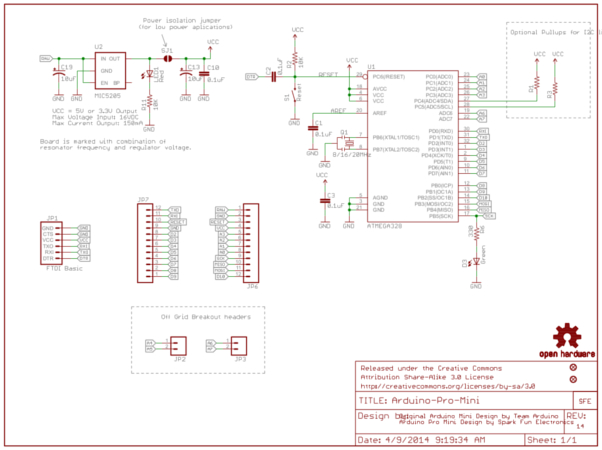
Arduino pro mini eagle lbr pro#
Better yet, have the Pro Mini talk with the ESP8266 to connect online and have the LEDs react to the weather in your region! LED Cloud-Connected Cloud - Add the Pro Mini with some WS2812-based Addressable LEDs to light up a cloud for an installation.Reducing Arduino Power Consumption - Reduce current draw on your Arduino project.Interactive Hanging LED Array- Create a giant LED array driven by the Arduino Pro Mini.Mario the Magician's Magical Lapel Flower - This project uses a Pro Micro to control the magical flower, but that could be swapped out for a Pro Mini too.

MP3 Player Shield Music Box - This project uses an Arduino to control the MP3s and motors, but it'd be interesting to swap that out for a Pro Mini.The Uncertain 7 Cube - The Pro Mini is the brains of this fun riff on the magic 8-ball.Wake on Shake - Add the Wake on Shake to provide power briefly to a Pro Mini only when there is a shake or bump.Now that you know the basics of hooking up the Arduino Pro Mini, what project are you going to stick it into? Need some inspiration? Check out some of these tutorials and videos.
Arduino pro mini eagle lbr free#
Like its predecessor, the Arduino Pro Mini is open-source hardware, which means all of the design files are free to view and modify.įor more information on the Arduino Pro Mini, first check out our product page as well as Arduino's Pro Mini homepage. Keep in mind that this option may not be available when your project has entered the wild, absent from any computers or USB supplies. The FTDI Basic Breakout can be used to power the Mini via your computer's USB port. There is a third power option that's only usually available while you're programming the Pro Mini. Don't forget to connect the grounds (GND) too! This will bypass the regulator and directly power the ATmega328. If you already have a regulated 3.3V source from somewhere else in your project, you can connect that directly to the VCC pin. The voltage applied here is regulated to 3.3V before it gets to the processor. This pin is akin to the VIN pin, or even the barrel jack, on the Arduino Uno. If you have a supply that's greater than 3.3V (but less than 12V), you'll want to connect that to the RAW pin on the Mini. Or you could use a wall power supply along with a barrel jack adapter. If you want something that matches the compactness of the Pro Mini, a battery - LiPo, alkaline, coin cell, etc. Pick a power source that suits your project.

The Pro Mini doesn't have a barrel jack, or any other obvious way to connect a power supply, so how do you power the thing?

The most important factor in any project is what's going to power it. That said, don't let the slower speed scare you away from using the Mini 8MHz is still plenty fast, and the Mini will still be capable of controlling almost any project the Arduino Uno can. We put a slower resonator on the Mini to guarantee safe operation of the ATmega. The Pro Mini 3.3V runs at 8MHz, half the speed of an Arduino Uno. This means that if you've got peripherals that only work at 5V, you might have to do some level shifting before you hook it up to the Pro Mini (or you could go for the 5V variant of the Pro Mini).Īnother major variation from the standard Arduino lies in the speed at which the ATmega328 runs. Unlike the Arduino Uno, which has both a 5V and 3.3V regulator on board, the Mini only has one regulator. The first glaring hardware difference is the voltage that the Mini operates at: 3.3V. The Mini packs almost as much microprocessor-punch as the regular Arduino, but there are a few major hardware changes you should be aware of before you start adapting your project to the Mini. Comparing the size of a standard Arduino Uno with the (aptly named) Pro Mini.


 0 kommentar(er)
0 kommentar(er)
